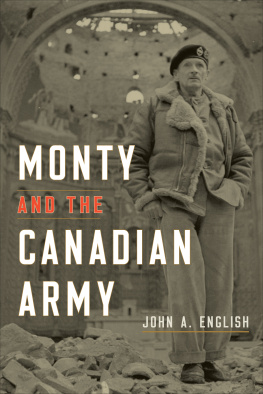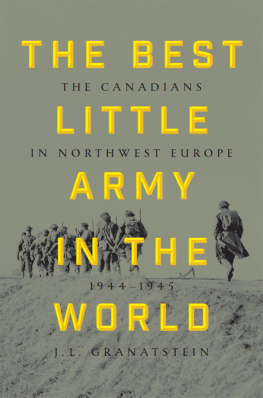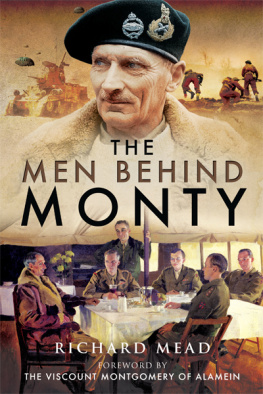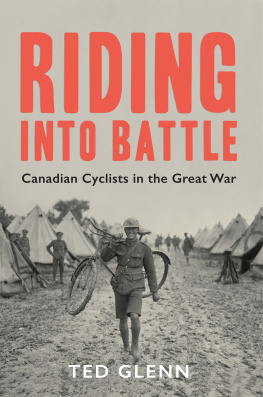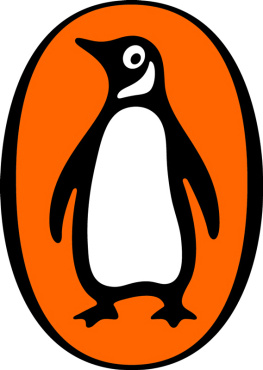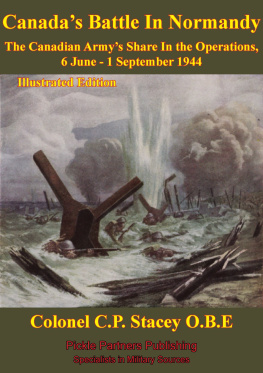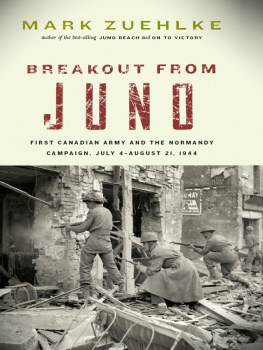JOHN A. ENGLISH
Title: Monty and the Canadian Army / John A. English.
Names: English, John A. (John Alan), author.
Description: Includes bibliographical references and index.
Identifiers: Canadiana (print) 20210216239 | Canadiana (ebook) 2021021628X | ISBN 9781487506995 (cloth) | ISBN 9781487535377 (EPUB) | ISBN 9781487535360 (PDF)
Subjects: LCSH: Montgomery of Alamein, Bernard Law Montgomery, Viscount, 18871976 Military leadership. | LCSH: Canada. Canadian Army. | LCSH: Generals Great Britain Biography. | LCSH: World War, 19391945 Canada. | LCGFT: Biographies.
University of Toronto Press acknowledges the financial assistance to its publishing program of the Canada Council for the Arts and the Ontario Arts Council, an agency of the Government of Ontario.
Preface
I have studied Canadian and Allied ground force operations in the Battle of Normandy and beyond for several decades as both a Queens University PhD candidate and member of the Directing Staff of the Canadian Land Forces Command and Staff College. I also served as a war plans officer in NATOs Central Army Group Headquarters during the Cold War, Chief of Tactics at the Canadian Combat Training Centre, and Professor of Strategy at the US Naval War College.
In the course of my studies, which resulted in three books, I was struck by the marked influence of Field Marshal B.L. Montgomery on Canadian Army training and operations during the Second World War and well on into the post-war period. Here much of his influence flowed vicariously through the actions of his Canadian disciples, most notably Lieutenant General Guy Simonds. Eventually, as the sheer depth and breadth of Montgomerys professionalism and military influence became more and more apparent, I decided to undertake a closer examination of the relationship between him and the Canadian Army.
This proved a vast challenge as Montgomerys mastery of military operations ran the gamut from minor tactics to large-scale formation deployments. The emphasis he placed on basic fighting skills and realistic training for war through properly conducted test exercises and rehearsals set him apart from other generals of the time. His main problem was how to ensure that his fighting methods trickled down to the lowest levels of command,
As a first step I explored the roots of Montgomerys growth and development as a skilled field commander, which are set forth in leadership focus on training for operations, completely lost the military professionalism that characterized this legendary corps.
Montgomery in contrast became the quintessential professional officer and from the crucible of Dunkirk rose to command two British Army corps, as recounted in .
Montgomerys second and most consequential contact with Canadian soldiers occurred in 1942, when he inspected all units of the Canadian Corps, and is detailed in with a view to establishing his responsibility for that operation.
examines the underpinnings of Montgomerys victory at Alamein, which catapulted him into international prominence and reinforced the confidence of Canadian soldiers in his command and leadership. This chapter also covers the entry of Simondss 1st Canadian Infantry Division into the battle for Sicily, where Montgomery personally intervened in Canadian higher-command matters for better and for worse. The later deployment of Lieutenant General H.D.G. Crerars 1 Canadian Corps to Italy spawned a further high-command altercation that had to be adjudicated by Montgomery, who, by this time, held Simonds in the highest esteem.
During planning for the Normandy invasion Montgomery began to harbour doubts about Crerars field qualifications to command the First Canadian Army, now comprising the British 1 Corps and 2 Canadian Corps. When the First Canadian Army finally did deploy under Crerar, as explained in , he almost immediately got into a quarrel with his 1 Corps commander, which dispute additionally fell on Montgomery to resolve.
The first major attack launched by the First Canadian Army, Operation Totalize, is analyzed in some detail in because it has been the subject of much debate that continues to this day. Criticisms levelled against Montgomery for his failure to reinforce the First Canadian Army and cut the Germans off at Falaise are also addressed in this chapter.
along with Crerars celebrated spat with Montgomery and Simondss inspired generalship in the Battle of the Scheldt. Montgomerys alleged lack of focus on opening the port of Antwerp is coincidentally considered from both tactical and strategic perspectives.
, the continued military influence of Montgomery on Canadian Army training and doctrine in the two decades following the war is traced.
In amassing documentation for this book over the years I received support from many quarters. At the Imperial War Museum, the late Roderick W.A. Suddaby, the Keeper of the Department of Documents, went out of his way to accommodate my visits there. I remain further beholden to the trustees of the Imperial War Museum for allowing me access to the Montgomery Collections and to the late Right Honorable The Viscount Montgomery of Alamein, CMG, CBE, for permission to use quotations from the materials I acquired. Similarly, Patricia J. Methven, Kate OBrien, and the staff of Kings College London provided me with much valuable material, and I am grateful to Katrina DiMuro and the Liddell Hart and Alanbrooke Trustees for permission to use quotations from the Alanbrooke, Liddell Hart, and Pyman papers. Dave Reisch, my guiding editor at Stackpole Books, also kindly granted permission to use excerpts from my published works under the Stackpole imprint.
I would also like to thank the archivists and staff at the Public Records Office in Kew, London, the National Archives and Records Administration II in College Park, Maryland, the Dwight D. Eisenhower Library in Abilene, Kansas, the George C. Marshall Foundation Library and Archives in Lexington, Virginia, the U.S. Army Military History Institute, Carlisle Barracks, Pennsylvania, the U.S. Military Academy Library at West Point, the National Archives of Canada (now Library and Archives Canada), the Royal Military Colleges Massey Library, and the Queens University Archives in Kingston, Ontario.
I owe a special debt to David Willis, Richard Palimaka, and the staff at the Fort Frontenac Library of the Canadian Land Forces Command and Staff College, surely the best military library in Canada. David McCarey of the Military Communications & Electronics Museum also allowed me access to the Lieutenant General S.F. Clark papers. Sincere thanks are further due to Mitch Kryzanowski, MA War Studies, and Terry Poulos, an accomplished author of military history who has degrees from the Universities of Toronto and Chicago, where he studied respectively under C.P. Stacey, Michael Geyer, and William H. McNeill. Both offered invaluable criticism and sound counsel that reflected their unsurpassed knowledge and understanding of Canadian and military history. I remain similarly appreciative to John A. Macdonald, MA War Studies, and John Selkirk of Reserves 2000 for reviewing drafts and making suggestions.

